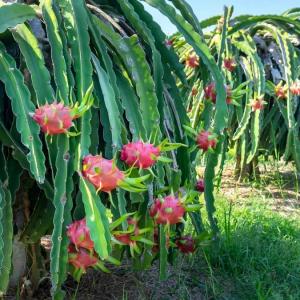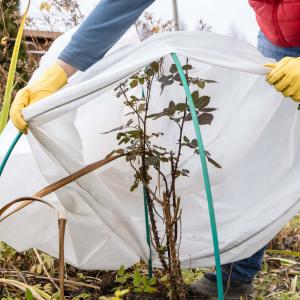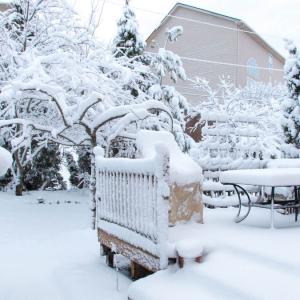When it is grown in pots, as an apartment plant , due to the conditions, the ficus adapts and does not exceed two or three meters in height. Ficus Elastica generally has a single straight stem, with large, rounded leaves, 30 centimeters (9,8 ft) long and glossy green on the upper side and reddish on the lower side. The terminal shoots are wrapped in a bract with a pink tint. There are several varieties of Ficus Elastica: Ficus Elastica Decora, Rubra, Schrijverieana or Tricolor. Ficus Elastica is a relatively easy plant to grow and is very often found as an apartment plant.
Ficus care
If you are among those who chose to have a ficus among the plants in the apartment, then you must know that the pot should be placed in a very well-lit place, but the plant must be sheltered from the direct rays of the sun. Ficus Elastica is sensitive to cold and needs temperatures above 15 degrees Celsius (59 Fahrenheit).
In warm periods, the pot can be moved outside, but it must be protected from the strong rays of the sun. When you decide to move the plant to the balcony or to the garden, it is recommended to do this gradually, waiting for the difference in temperature from day to night to be no longer large. The best time to move the plant outside is the end of spring, beginning of summer.
Also, from April until September, the Ficus Elastica is watered regularly, the soil having to be well dry. Watering is done with water at room temperature, preferably in the morning. Be careful when watering it, because if it is in excess, you will only harm the plant, which will lose its leaves. With the arrival of autumn, it will be watered less often. Ficus Elastica does not like dry climates and therefore it is recommended that the leaves be sprayed with demineralized water as often as possible to avoid the formation of spots. Regarding the soil in the pots, in this case a substrate rich in organic substances and very well drained will be used. Transplanting the plant is best done in the spring, at intervals of two years, until the plant becomes big enough, after which this operation will be avoided as much as possible. For this reason, it is recommended to use pots as large as possible. Correcting the height and stimulating the branching are done by cuttings performed in March.
Once every two or three weeks, you will have to practice cleaning the leaves, an operation that consists in wiping the leaves of dust with a wet cloth. An operation that you do with pleasure, because the beautiful and glossy green of the leaf is its calling card. Along with this operation, the dry or yellowed leaves on the stem will also be removed.
If you notice that the leaves of your ficus are turning yellow, then you should know that it is a sign that the plant is suffering from a lack of nitrogen, phosphorus or potassium. To remedy this aspect , these mineral fertilizers will be administered to the plant by dissolving them in the irrigation water, a treatment that we will apply once every two or three weeks.
We will treat the diseases that may appear in our ficus with a series of fungicides such as: Dithane, Curzate or Bravo and we will remove new pests with the insecticides: Calypso, Mospilan or Reldan, which are also found on the common and European agricultural market.
Ficus cutting
Ficus should be periodically pruned to stimulate branching. However, the operation is not performed by chance, but some aspects must be taken into account. Thus, it is best to cut in the winter because less sap flows from the stem. Also, cut about 1-2 centimeters above a leaf, and after cutting quickly put compost or dry soil on the wound to stop the flow of latex, which can also irritate your skin. You must know that the branching will start from the base of the last leaves, so take into account their orientation.
Reproduction, parasites and diseases
In favorable conditions, during a year the branches grow a lot and there are situations where, in a simple block room, there is a ficus with very long branches (two-three meters). This is the reason why the cuts must be made as short as possible. There are several types of crown, but in general they resemble those of fruit trees and any ficus can be directed like them. It is good that the cut shoot is a little woody.
If the ficus was cut in the spring, new plants can be obtained from the tops obtained (if they are not very raw) . The tips of the cut branch are sectioned immediately below the last node, from which the leaf is removed, after which they are placed in bottles of water, at a window, on the windowsill, in the light and heat . Rooting occurs in one or two months.
Propagation of this type of ficus is done by cuttings. For this, top cuttings with two to four leaves or stem fragments with one or two leaves are made, which are kept in hot water for 10-15 minutes, to stop the latex. The cuttings take root in about four to six weeks, either in a mixture of peat and sand, or in water bottles.
As far as pests are concerned, the ficus is often attacked by mites and mites, which nest under the large leaves, especially in a dry climate.
Ficus Benjamin
If you want to have a special decoration in your room and create an unforgettable atmosphere, then you should consider buying a Ficus Benjamin. Haven't you heard of him? Then we tell you that this species of ficus is also known as the "rubber plant", due to its leaves that seem to be made of rubber.
The Benjamin ficus is not too difficult to take care of, it loves light and heat, and that's why we recommend placing it somewhere near the window. If you want to move it somewhere in the garden during the summer, place it in a place with a little shade, and not in direct sunlight. If it does not have enough light, the leaves of this species of ficus begin to fall. Watering the Ficus Benjamin is done regularly, allowing the soil to dry slightly between two waterings. It is recommended to spray the leaves with water daily to keep the air humidity high.
Your little tree also needs food once every two weeks in the summer and monthly in the winter. Therefore, you need a fertilizer for green plants that you can find at any specialty store. And if you are the type that likes your plants to be well cared for and to have a pleasant appearance, you should know that the Ficus Benjamin must be cut in the spring (usually in March) and the leaves must always be cleaned of dust with a damp sponge. Do not move it too often from the place where you arranged it for the first time because moving it leads to the temporary loss of leaves that recover after the plant has adjusted to the new location.
If you notice that the leaves of the Ficus Benjamin start to turn black, dry and even fall, you should know that this is due to too much soil moisture, temperature and inadequate light in the environment. In order for it to recover, move it to a place where it receives more light and the temperature is approximately 20 degrees C (68 Fahrenheit). On the other hand, the yellowing of the leaves indicates that your ficus needs water or is attacked by pests. In this case, do not panic, and proceed to their removal with insecticides from the neonicotinosis class (in the case of woolly lice) and specific acaricides that you can find in gardening stores.
Propagation of this species of ficus is done in the spring, by cuttings that are taken from the top of the plant or from the side branches, not very young, but slightly woody. After cutting the cutting, leave 3-4 leaves, then you can cut the cutting slightly obliquely under the last node and you will hold it under a stream of water until the flow of sap stops, which, like ficus elastica, causes slight skin irritations. You will then put the cutting in a transparent container that will contain water, a little wider at the mouth to remove the cutting without injuring its roots. The cuttings can also be placed in well-watered soil mixed with peat. They must be kept at temperatures of 25 degrees C (77 Fahrenheit) until they give roots, after which they will be planted in pots.
Ficus Alii
Ficus Alii is a variety of shrub that is becoming more and more popular. Due to its narrow, dark green leaves, it is a very beautiful plant. It is less pretentious to take care of than Ficus Benjamina and fits equally well in decorative exterior landscapes, as well as in interior ones. Like all ficus species, this one also suffers from falling leaves until it adapts to the environment in which it is brought. On the other hand, due to its ability to purify the air, because it is easy to maintain and resistant to pest attack, Ficus Alii is the perfect choice for the home or office . It can be placed either in light or semi-shade.
Removes toxins
Ficus, regardless of the species we have, is preferred because it is easier to care for than other houseplants. In fact, it is a plant that is very easy to grow and maintain and has proven to be extremely effective in removing formaldehyde. In addition, after the tests, it was found that the ficus best removes chemical toxins from the environment. The very milky sap from the body of the plant can sometimes be irritating in contact with the skin and cause digestive disorders if ingested. And, as a small detail, it is also believed that the Ficus, in all its forms, brings strife, that is why it is also called "the plant of enmity".







